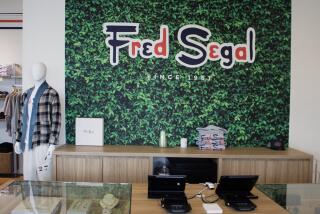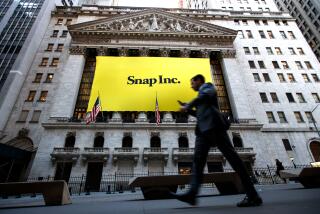Apparel Retailer Seeking Cohesive Strategy to Bridge Generation Gap
Christy Brigandi stopped shopping at Gap and Old Navy stores last year, unable to find clothes that she liked.
Now, however, Brigandi is back in the fold -- big time.
Brigandi shopped at the Old Navy store in Costa Mesa this week wearing a Gap top, Banana Republic pants and an Old Navy jacket, all Gap Inc. brands. And her shopping bag was jammed with Old Navy children’s clothes.
“I have five children, so it’s a good spot for them,” said the stay-at-home mom from Newport Beach. The 39-year-old noted that she spends an average of $200 to $300 on each trip to Old Navy, a store she has visited twice this year.
Gap is hoping to tap more customers like Brigandi as the nation’s largest apparel retailer continues to try to turn itself around.
The San Francisco-based company on Thursday logged a fiscal fourth-quarter profit of $249 million, or 27 cents a share, reversing a loss of $34 million, or 4 cents, in the same period a year earlier. Revenue for the quarter ended Feb. 1 increased 14% to $4.7 billion.
Sales at stores open at least a year, a key industry indicator, rose 8%, contrasted with a decline of 16% in the year-ago fourth quarter.
Despite the rebound, analysts say Gap still has considerable challenges ahead, including developing a cohesive strategy for its namesake stores in the U.S.
While Gap stores struggle to find their groove, Old Navy has started to race ahead as the lower-priced chain strikes a chord with today’s bargain-driven shoppers. Indeed, Gap’s same-store sales in the U.S. gained 4% in the fourth quarter, while Old Navy’s comparable-store sales jumped 14%.
And for the first time, annual sales at the company’s 842-store Old Navy unit outpaced its Gap U.S. division, with nearly three times as many locations. Old Navy had $5.8 billion in sales, compared with Gap’s $5.1 billion.
Old Navy “has returned to its roots of being basic and hip and affordable, all at the same time,” said Robert Buchanan, an analyst with A.G. Edwards & Sons. But the flagship Gap chain “still has to figure out who the customer is.”
Kay Mulvaney agrees. At Old Navy, “the prices, for the quality, are the best,” the 45-year-old computer saleswoman said after a trip to the Costa Mesa store this week. The Corona del Mar resident shops at Gap, too, but finds it much harder to leave Old Navy empty-handed.
“I didn’t need any of this stuff,” she said, poking through her shopping bag. “But I bought it.”
Gap, the king of casual wear throughout the 1990s, struggled mightily in recent years after it veered off course, stocking trendier apparel in an attempt to win favor with younger shoppers.
With its core customers abandoning ship, Gap began a “back to basics” push last year, filling stores with old favorites: khakis, jeans and cotton shirts.
But its vision still seems a little muddy to some. As far as Sue Gaitan is concerned, the clothes aren’t basic enough. In particular, their cut is too youthful to suit the 40-year-old Newport Beach resident.
The pants “are really fitted and the pockets stick out, or it’s that low stuff,” Gaitan said outside the Gap store at South Coast Plaza this week. “A lot of their basics are not basic.”
On the other hand, 25-year-old Jonathan Noeldechen thinks that the clothes are too basic. The Los Angeles resident stopped at the same Gap store with two friends Tuesday, but all left without shopping bags.
“They need some, like, ‘pop,’ ” Noeldechen said.
Such reaction among shoppers is one reason Buchanan and other analysts think that Gap needs to better define itself.
The specialty apparel retailers that are racking up sizable sales gains these days tend to have a sharp focus, such as Anaheim-based Pacific Sunwear of California and Hot Topic Inc. in City of Industry.
Gap is “trying to be ‘every age, every lifestyle,’ and you can’t do that in a 6,000-square-foot store and succeed,” Buchanan said.
Better understanding Gap’s customer is a major aim for Paul Pressler, the former Walt Disney Co. executive who was hired as Gap’s chief executive in September.
In a conference call Thursday, Pressler said Gap was surveying customers and doing other research to figure out what kind of shopper visits its stores.
The company also said it was boosting its spending on print and TV advertising.
Sales trends have not been encouraging for February, partly because frigid weather in some parts of the country has kept consumers hunkered down at home instead of shopping.
Gap shares rose 6 cents to $14.82 on the New York Stock Exchange. The fourth-quarter results were released after the market closed. In after-hours trading, the stock fell to $14.35.
For the year, the company earned $477 million, or 54 cents a share, contrasted with a loss of $8 million in fiscal 2001. Sales rose 4% to $14.5 billion.
The latest results included a tax-rate reduction and an after-tax charge related to leases. Same-store sales fell 3% for the year, compared with a 13% drop in 2001.
For Pressler and his executive team, one trick will be to figure out how to balance the Old Navy and Gap chains. In the last few years, the company has been faced with the fact that Old Navy has been cannibalizing Gap’s customers.
“Consumers viewed Old Navy’s merchandise as essentially the same as Gap’s, except that at Old Navy it was priced 40% lower,” Brian Tunick, an analyst at J.P. Morgan Securities, said in a recent report.
“Every time a sale was made at Old Navy,” Tunick added, “it was one less sale at the Gap.”
Pressler acknowledged that the company needs to get better at keeping customers like the Brigandis within the fold.
“We all recognize the work we still have to do,” he said.
More to Read
Inside the business of entertainment
The Wide Shot brings you news, analysis and insights on everything from streaming wars to production — and what it all means for the future.
You may occasionally receive promotional content from the Los Angeles Times.










